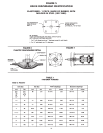
13
Retrofit - The switch package as received from
the factory is pre-set, only minimal adjustment
is required to adapt to the actuator.
6.1 Field Mounting (1/4” through 1”, DIN 8 - 25)
6.1.1Remove the four(4) stainless steel screws on
the actuator top cover. Place the valve in the
open position.
6.1.2Remove the plastic plug from the indicating
spindle.
6.1.3Mount the adapter, insure that both 0-Rings
are on the adapter and lubricated with Dow
111. The correct torque is 5 in-lbs (.565 Joules).
6.1.4Place the washer on the adapter. Thread the
switch indicating spindle (item 12) into the
actuator spindle. Use Blue Loctite #242.
6.1.5Slide the switch sub assembly down over the
adapter, position the conduit entrances in the
location most desirable, (45˚ increments), press
down and tighten the set screw located on the
side of the lower housing to lock the unit in
place. The set screw torque should not exceed
5 in-lbs (.565 Joules).
6.1.6Attach target assembly (item 9) to switch indi-
cating spindle (item 12) using shoulder screw
with Belleville washers in place. Use Blue
Loctite #242. Run field wires and conduit to
terminal strip. (Reference factory wiring tag.)
Verify the switches operate correctly by cycling
the valve, see 6.2 for switch adjusting proce-
dure. Screw the switch package cover on,
insure the O-Ring remains in the groove.
6.2 Setting Switches
(Switches are identified with decal)
6.2.1Remove top switch package cover.
6.2.2Place valve in full open position.
6.2.3Connect test device to terminal strip on con-
nections identified for open switch. The switch
type, inductive proximity versus dry contact
mechanical, determines the type of test device
required. Contact switches use a traditional
volt meter with resistance capability to verify
continuity, inductive proximity switches cannot
use this method. Proximity switches require an
inductive proximity tester, such as
Pepperl+Fuch’s model #1 - 1350, which sup-
plies the proper load and supply voltage to the
switch. Inductive proximity switches must be
energized with the correct load and supply
voltage to sense the target.
WARNING: DO NOT SHORT THE INDUCTIVE
PROXIMITY SWITCH BY DIRECTLY CONNECT-
ING A POWER SUPPLY, IRREPARABLE AND
IMMEDIATE DAMAGE CAN OCCUR TO THE
SWITCH.
6.2.4Use the switch actuator (item 7) accessible
from the top to set the optimum position. (Two
turns past the trigger location is recommend-
ed.)
6.2.5Place the valve in the full closed position.
6.2.6Replace the top switch package cover.
7 SWITCH PACK 3.0
(The switch package is not autoclavable,
maximum switch temperature is 140˚F,
60˚C.) (Switches and Positioners cannot be
used together.)
Retrofit - The switch package as received from
the factory on valve assemblies is pre-set, only
minimal adjustment is required to adapt to the
actuator.
7.1 Field Mounting (1/4” through 2”, DN 8 - 50)
7.1.1Remove the four (4) stainless steel screws on
the actuator top cover. Place the valve in the
open position.
7.1.2Remove the plastic plug from the indicating
spindle.
7.1.3Insure all O-Rings are on the adapter and lubri-
cated with Dow 111. Slip the switch indicating
spindle, #10-24 UNC threads first, through the
adapter until the threads are exposed. Apply
Blue Loctite #242 to the threads, thread the
switch spindle into the actuator spindle until it
shoulders.
7.1.4Attach the adapter to the upper cover. The cor-
rect torque is 5 in-lbs (.565 Joules).
7.1.5Thread the appropriate switch actuator(s) on
the spindle.
7.1.6Position the closed switch actuator approxi-
mately 0.14” (4 turns) from end of threads and
position the open switch actuator approximate-
ly 0.25” (7 turns) below the top of the spindle,
do not tighten the set screw.
7.1.7Remove the switch package top cover, slide the
sub assembly down over the adapter using
care not to damage the switch internals
(specifically the mechanical switch levers).
Position the conduit entrance in the location
most desirable, press down and tighten the set
screw located on the side of the lower housing
to lock the unit in place. Note that the plastic
adapter has two molded counterbores.
Locating the set screw in one of these holes
provides maximum resistance to conduit rota-
tion. The set screw torque should not exceed 5
in-lbs. (.565 Joules).
7.1.8Run field wires and conduit to the terminal
strips. Verify the switches operate correctly by
cycling the valve. See 7.2 for switch adjusting
procedure. Screw the switch package top cover
on.
7.2 Setting Switches


















